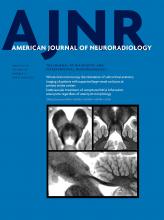Index by author
Bathla, G.
- LetterYou have accessEngorged Medullary Veins in Neurosarcoidosis: A Reflection of Underlying Phlebitis?G. Bathla, N. Soni, T. Moritani and A.A. CapizzanoAmerican Journal of Neuroradiology March 2019, 40 (3) E14-E15; DOI: https://doi.org/10.3174/ajnr.A5951
Baxter, B.W.
- EDITOR'S CHOICEYou have accessImaging of Patients with Suspected Large-Vessel Occlusion at Primary Stroke Centers: Available Modalities and a Suggested ApproachM.A. Almekhlafi, W.G. Kunz, B.K. Menon, R.A. McTaggart, M.V. Jayaraman, B.W. Baxter, D. Heck, D. Frei, C.P. Derdeyn, T. Takagi, A.H. Aamodt, I.M.R. Fragata, M.D. Hill, A.M. Demchuk and M. GoyalAmerican Journal of Neuroradiology March 2019, 40 (3) 396-400; DOI: https://doi.org/10.3174/ajnr.A5971
Endovascular thrombectomy has proven efficacy for a wide range of patients with large-vessel occlusion stroke and in selected cases up to 24 hours from onset. While primary stroke centers have increased the proportion of patients withstroke receiving thrombolytic therapy, delays can be encountereduntil patients with LVO are identified and transferred from the primary stroke center to acomprehensive stroke center. Therefore, any extra steps need to be carefullyweighed. The use of CTA (especially multiphase) at the primary stroke center levelhas many advantages in expediting the transfer of appropriate patients to a comprehensive center.
Baxter, L.C.
- FELLOWS' JOURNAL CLUBAdult BrainOpen AccessAccurate Patient-Specific Machine Learning Models of Glioblastoma Invasion Using Transfer LearningL.S. Hu, H. Yoon, J.M. Eschbacher, L.C. Baxter, A.C. Dueck, A. Nespodzany, K.A. Smith, P. Nakaji, Y. Xu, L. Wang, J.P. Karis, A.J. Hawkins-Daarud, K.W. Singleton, P.R. Jackson, B.J. Anderies, B.R. Bendok, R.S. Zimmerman, C. Quarles, A.B. Porter-Umphrey, M.M. Mrugala, A. Sharma, J.M. Hoxworth, M.G. Sattur, N. Sanai, P.E. Koulemberis, C. Krishna, J.R. Mitchell, T. Wu, N.L. Tran, K.R. Swanson and J. LiAmerican Journal of Neuroradiology March 2019, 40 (3) 418-425; DOI: https://doi.org/10.3174/ajnr.A5981
The authors evaluated tumor cell density using a transfer learning method that generates individualized patient models, grounded in the wealth of population data, while also detecting and adjusting for interpatient variabilities based on each patient's own histologic data. They collected 82 image-recorded biopsy samples, from 18 patients with primary GBM. With multivariate modeling, transfer learning improved performance (r = 0.88) compared with one-model-fits-all (r = 0.39). They conclude that transfer learning significantly improves predictive modeling performance for quantifying tumor cell density in glioblastoma.
Baylosis, B.
- Head and Neck ImagingYou have accessEtiology-Specific Mineralization Patterns in Patients with Labyrinthitis OssificansK. Buch, B. Baylosis, A. Fujita, M.M. Qureshi, K. Takumi, P.C. Weber and O. SakaiAmerican Journal of Neuroradiology March 2019, 40 (3) 551-557; DOI: https://doi.org/10.3174/ajnr.A5985
Beaujeux, R.
- NeurointerventionYou have accessPredictors and Clinical Impact of Delayed Stent Thrombosis after Thrombectomy for Acute Stroke with Tandem LesionsR. Pop, I. Zinchenko, V. Quenardelle, D. Mihoc, M. Manisor, J.S. Richter, F. Severac, M. Simu, S. Chibbaro, O. Rouyer, V. Wolff and R. BeaujeuxAmerican Journal of Neuroradiology March 2019, 40 (3) 533-539; DOI: https://doi.org/10.3174/ajnr.A5976
Becske, T.
- CommentaryYou have accessPipeline Sizing Based on Computer SimulationT. BecskeAmerican Journal of Neuroradiology March 2019, 40 (3) 531-532; DOI: https://doi.org/10.3174/ajnr.A5998
Bendok, B.R.
- FELLOWS' JOURNAL CLUBAdult BrainOpen AccessAccurate Patient-Specific Machine Learning Models of Glioblastoma Invasion Using Transfer LearningL.S. Hu, H. Yoon, J.M. Eschbacher, L.C. Baxter, A.C. Dueck, A. Nespodzany, K.A. Smith, P. Nakaji, Y. Xu, L. Wang, J.P. Karis, A.J. Hawkins-Daarud, K.W. Singleton, P.R. Jackson, B.J. Anderies, B.R. Bendok, R.S. Zimmerman, C. Quarles, A.B. Porter-Umphrey, M.M. Mrugala, A. Sharma, J.M. Hoxworth, M.G. Sattur, N. Sanai, P.E. Koulemberis, C. Krishna, J.R. Mitchell, T. Wu, N.L. Tran, K.R. Swanson and J. LiAmerican Journal of Neuroradiology March 2019, 40 (3) 418-425; DOI: https://doi.org/10.3174/ajnr.A5981
The authors evaluated tumor cell density using a transfer learning method that generates individualized patient models, grounded in the wealth of population data, while also detecting and adjusting for interpatient variabilities based on each patient's own histologic data. They collected 82 image-recorded biopsy samples, from 18 patients with primary GBM. With multivariate modeling, transfer learning improved performance (r = 0.88) compared with one-model-fits-all (r = 0.39). They conclude that transfer learning significantly improves predictive modeling performance for quantifying tumor cell density in glioblastoma.
Bergsland, N.
- Adult BrainYou have accessA Serial 10-Year Follow-Up Study of Atrophied Brain Lesion Volume and Disability Progression in Patients with Relapsing-Remitting MSR. Zivadinov, D. Horakova, N. Bergsland, J. Hagemeier, D.P. Ramasamy, T. Uher, M. Vaneckova, E. Havrdova and M.G. DwyerAmerican Journal of Neuroradiology March 2019, 40 (3) 446-452; DOI: https://doi.org/10.3174/ajnr.A5987
Berlis, A.
- EDITOR'S CHOICENeurointerventionYou have accessEndovascular Treatment of Unruptured MCA Bifurcation Aneurysms Regardless of Aneurysm Morphology: Short- and Long-Term Follow-UpF. Hagen, C.J. Maurer and A. BerlisAmerican Journal of Neuroradiology March 2019, 40 (3) 503-509; DOI: https://doi.org/10.3174/ajnr.A5977
Between May 2008 and July 2017, endovascular treatment of 1184 aneurysms in 827 patients was performed in a single institution. Twenty-four percent of these aneurysms were located at the MCA, and 150 unruptured MCA bifurcation aneurysms treated with coiling, stent-assistedcoiling, or endovascular flow diverter (WEB device) were identified for this retrospective data analysis. The procedure-associated good clinical outcome was 89.9%, and the mortality rate was 2.7%. Short-term follow-up good clinical outcome/mortality rates were 91.3%/0.7%. At discharge, 137 patients had an mRS of 0–2 (91.3%) and 13 had an mRS of 3–6 (8.7%). The authors conclude that regardless of the architecture of MCA bifurcation aneurysms, endovascular treatment can be performed with low morbidity/mortality rates.
Bhadelia, R.A.
- Head and Neck ImagingYou have accessDiagnostic Utility of Optic Nerve Measurements with MRI in Patients with Optic Nerve AtrophyB. Zhao, N. Torun, M. Elsayed, A.-D. Cheng, A. Brook, Y.-M. Chang and R.A. BhadeliaAmerican Journal of Neuroradiology March 2019, 40 (3) 558-561; DOI: https://doi.org/10.3174/ajnr.A5975








